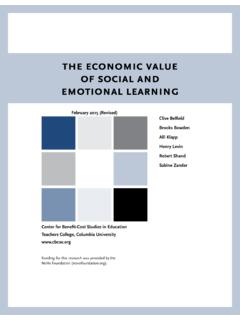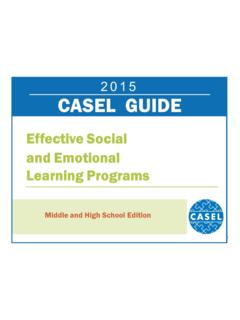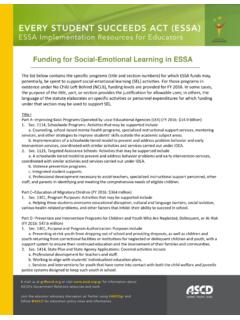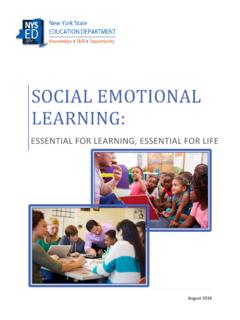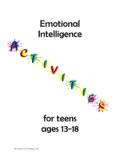Transcription of Social Emotional Learning in High School: How …
1 OStanford Center for Opportunity Policy in EducationsceSCOPE ~ Research BriefThe Context: Social , Emotional , and Academic Learning in high Schoolhe psychological, Social , and Emotional aspects of education have enjoyed increased attention in recent years as oft-termed non-cognitive factors and soft skills have gained traction in research, policy, and practice cir-cles as major drivers of student This renewed attention represents an important shift, as Social and Emotional supports for students in school have frequently been called the missing piece in the accountability-driven practices that are the legacy of No Child Left Further, failing to meet students psychological, Social , and Emotional needs will continue to fuel gaps in oppor-tunity and achievement for students in particular, low-income students and students of color who are frequently underserved by the schools they Researchers in the field of Social Emotional Learning .
2 Commonly referred to as SEL, are working to better understand how schools can effectively implement practices that meet students Social and Emotional needs and provide them with the opportunity to learn adaptive skills to succeed both inside and outside of the Social Emotional Learning is commonly defined as the processes through which students acquire and effectively apply the knowledge, attitudes, and skills necessary to understand and manage emotions, set and achieve posi-tive goals, feel and show empathy for others, establish and maintain positive relationships, and make responsible decisions.
3 5 Much of the existing research in the field has focused on elementary and, to a lesser extent, middle schools, where fostering Social and Emotional skills is often seen as part of the educational mission and early intervention is As a result, little is known about what effective Social Emotional Learning practice looks like at the high school level a gap that this study seeks to fill. We studied three very different high schools that have centered their work on developing young people as whole human beings who are socially and emo-tionally aware and skilled, who engage a growth mindset that enables them to persevere when challenged, who learn to be mindful, conscientious, and em-powered, and who develop a sense of Social responsibility about making posi-tive contributions to their school community and the wider community beyond.
4 We designed our study to address the following questions:1. How is effective Social Emotional Learning practiced in high schools?7 In particular, what can we learn from high schools that have developed an explicit mission to prepare students to be personally and socially aware, skilled, and responsible?TBy MarYam G. Hamedani and Linda Darling-HammondMarch 2015 About This SeriesFindings from SCOPE s Social Emotional Learning in Diverse high Schools study are published in three case studies, a cross-case report, a research brief, and a technical see the full series and related work, please visit research was made possible with support from the NoVo Foundation.
5 Stanford Center for Opportunity Policy in @scope_stanfordSocial Emotional Learning in high School: How Three Urban high SchoolsEngage, Educate, and Empower YouthStanford Center for Opportunity Policy in Education22. How can Social Emotional Learning strate-gies be tuned to meet the needs of students in diverse socioeconomic, racial, and ethnic schooling contexts?83. How does a systemic, whole- school ap-proach to Social Emotional Learning , in contrast to an interventionist or program-matic approach, function as a model of school -wide practice?
6 9 The Project: Learning From Models of Successful Practicehrough in-depth case studies of three ur-ban, socioeconomically and racially diverse small public high schools, a student survey, and a comparison of student survey results to a national sample of students, we investigate the ways in which school -wide Social Emotional Learning can be implemented and how these efforts shape students educational experiences. A particular feature of the schools we study is that they draw on an expanded vision of Social Emotional Learning that includes Social justice education as a means to develop Social respon-sibility and empower the student communities they serve as well as provide a culturally rel-evant, asset-based, and identity-safe Social Emotional Learning , as typically conceived in the field, seeks to foster students capacity to know themselves, build and main-tain supportive relationships.
7 And participate in their school communities as socially responsible citizens, a Social justice education perspective goes further to engage students in tackling issues of community advancement and Social justice education encompasses the conscious and reflexive blend of content and process in-tended to enhance equity across multiple Social identity groups ( , race, class, gender, sexual orientation, ability), foster critical perspectives, and promote Social action. 11 Social justice edu-cation seeks to bolster students sense of agency, leadership, and capacity to positively transform their own lives and the lives of others in their community, moving from awareness and under-standing to engagement and together, our primary research questions were:1.
8 How is Social Emotional Learning concep-tualized and implemented at these high schools? How is it informed or shaped by a Social justice education perspective?2. How do these schools practice Social emo-tional Learning to meet the needs of their respective urban, diverse student communi-ties and with what results?3. How does effective Social Emotional learn-ing practice shape students educational experiences and provide them with critical psychological resources that foster person-al, Social , and academic success?
9 Overview of Research Approach and MethodologyWe employed a multi-method, multiple case study research design. Schools were selected using a rigorous screening procedure that involved: nomination by a panel of experts in the fields of Social Emotional Learning and Social justice education, strong academic performance and attainment outcomes compared to each school s district, and a selection interview with school leaders and teachers to confirm a explic-it, well-established, school -wide focus on Social Emotional Learning and Social justice education.
10 The school sites we selected also represent a range of socioeconomic, racial, and ethnic diver-sity among the student communities they serve, which provided us with the opportunity to investigate how these factors impact the school context and student experiences (Table 1, pg. 3). The schools are: Fenway high school (Boston, MA), El Puente Academy for Peace and Justice (Brooklyn, NY), and International school of the Americas (San Antonio, TX). TSocial Emotional Learning in high school : How Three Urban high Schools Engage, Educate, and Empower Youth3 Qualitative data sources included: observa-tions ( , of classrooms, student events, and faculty meetings), document analysis ( , of school websites, student handbooks, and course syllabi), and interviews and focus groups (with school administrators, teachers, students, parents, and community partners).






